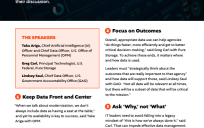Numerical data helps us grasp the magnitude of a problem. Personal stories give data a voice and invite us to connect with those around us who are most impacted by the problem.
The Interior Department (DOI) is using this dual approach to advance racial equity and support for underserved communities across U.S. recreational spaces. Other areas of focus include elevating equity within the DOI workforce, across agency contracting practices and through partnerships with tribal communities.
To advance these efforts, the agency partnered with a third-party, neutral facilitator in fall 2021 to conduct 15 virtual listening sessions. It reached more than 1,700 registrants in two weeks.
In light of President Biden’s January 2021 executive order, federal agencies have a renewed call to action for using data and a lens of racial equity to:
- Improve work conditions for government employees
- Address barriers people face when accessing government benefits and services
But you can’t effectively identify or adopt equitable practices without involving those closest to and impacted by inequities.
Accessible and Equitable Access to Public Lands
“Public land visitation data collected from the Department’s bureaus suggests that certain underserved communities are underrepresented as public land visitors relative to their presence in the U.S. population at large.” — DOI Executive Order 13985 Final Findings Report
Here are some of the barriers and recommendations that DOI heard from the 686 participants in listening sessions on public lands access:
Barriers
- Fear of encountering unwelcoming staff or other visitors
- Lack of representation in public lands frontline staff and multilingual resources
- Lack of time and money
- Limited transportation options
- Limited infrastructure supporting accessibility
Recommendations
- Focus on hiring staff with lived experience in disadvantaged communities.
- Invest in multilingual outreach materials, signage and resources for communities with limited English proficiency.
- Invest in public transit access, or partner to ensure it. Examine and seek to replicate local efforts such as King County, Washington’s “Trailhead Direct,” a transit-to-trails service.
- Analyze and budget for improved accessibility for limited mobility populations.
How to Frame the Conversation
To help you better understand how to facilitate meaningful conversations, we’re sharing some aspects of Interior’s approach to data gathering detailed in its final report.
Identify limitations early and often
For DOI, that meant recognizing the challenge of trying to do authentic and meaningful engagement during a pandemic, requiring virtual methods and having a short project timeline. It also meant acknowledging the many demands on underserved community members’ time before asking them to participate in the listening sessions.
Clearly define the goal(s) and intended stakeholder group
- The sessions were designed to prioritize the voices of underserved populations.
- DOI developed targeted stakeholder engagement lists while also acknowledging its own gaps in reaching the masses. The agency conducted outreach via social media and targeted emails with language outlining the goal of hearing from underserved communities. Efforts also included research into culturally specific organizations engaged in improving access to nature and the outdoors.
Ensure consistent focus areas across listening sessions
Sessions focused on topic-specific questions and were designed to consistently address three broad areas:
- Deeper understanding of perspective or experience with the issue/focus area, such as use of public lands
- Exploration of what is working well and what challenges participants have experienced
- Recommendations for quality improvement that will address barriers
DOI asked participants to reflect specifically on their and their communities’ experiences.
Account for the limitations of virtual interactions
- It’s hard to foster authentic and relational discussions virtually, so mixed methods for engaging were built into the process design. DOI provided opportunities for people to participate even if they could not attend the listening sessions.
- The sessions had whiteboards that allowed participants to use virtual sticky notes to share comments directly. A polling feature encouraged them to share background information and respond to topic-specific questions via text or online contributions, and Zoom chat functions allowed participants to provide general comments and/or additional written responses to discussion questions.
Success Factors
- Design listening sessions to ensure that the collected data is actionable.
- Include program staff and subject-matter experts from across the department to inform the entire project.
- Create a coding process to integrate multiple methods of qualitative contributions.
This article is an excerpt from GovLoop’s guide “Your Field Notes for Data-Driven Decision-Making in Government.”





Leave a Reply
You must be logged in to post a comment.